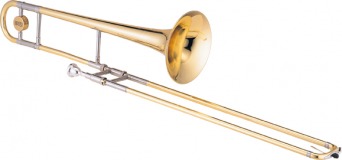Trombone

The word "trombone" comes from the Italian "tromba," which translates to "trumpet." The addition of the suffix "one" at the end of "tromba" means the word "trombone" translates to "large trumpet." Trombones are popular in symphonies, but jazz, reggae, and big band may feature a trombone.
The trombone is an instrument consisting of a mouthpiece, brass tubing, two slides and a bell. The trombone is a member of the brass family, meaning it is an instrument played by the use of vibrations. The vibrations, made by the lips, cause the air in the tubing to vibrate, poducing a sound out of the megaphone cone shaped end. In all, it takes three essential parts, the lips (embouchure), the slide, and the bell.
The trombone is an instrument consisting of a mouthpiece, brass tubing, two slides and a bell. The trombone is a member of the brass family, meaning it is an instrument played by the use of vibrations. The vibrations, made by the lips, cause the air in the tubing to vibrate, poducing a sound out of the megaphone cone shaped end. In all, it takes three essential parts, the lips (embouchure), the slide, and the bell.
Click picture below for video on embouchure
Positions

The slides of the trombone change the pitch of the sound coming out of the bell. The main slide is a stationary long brass tube that covers the second slide. The second slide is a brass handle allowing you extend down the main slide to change the pitch of the sound. Hence, the longer you extend the slide, the lower the pitch will be. There are seven positions at intervals along the slide, as shown in the picture.The first position is located closest to the mouthpiece, and the last is towards the end of the slide. By extending, the distance the vibrations from your lips have to travel through the tubing to the bell changes the pitch. In all, your embouchure plus the amount of distance from the mouthpiece to the bell changes the pitch.
Petal & Valve Trombones
The adding of a petal with extra tubing (left picture) allows the player to reach lower slide positions quickly by adding length to the tubing. Like, I explained earlier, longer tubing permits lower pitch. Having this little extra makes it easier to reach lower positions, such as seventh position, by simply going to second position, pressing down the pedal, and having the correct embouchure. All without having to reach all the way down to the far away seventh position.
A valve trombone (right picture) is not very common, when speaking to another person, and they say they play the trombone, most likely it is a slide trombone. A valve trombone is essentially, a larger trumpet. Instead of a slide that moves in and out, the valve trombone has three valves. These valves are pressed to create different pitches, similar to a trumpet. Valve trombones make it easier to play on long, melodic runs with complicated notation.
A valve trombone (right picture) is not very common, when speaking to another person, and they say they play the trombone, most likely it is a slide trombone. A valve trombone is essentially, a larger trumpet. Instead of a slide that moves in and out, the valve trombone has three valves. These valves are pressed to create different pitches, similar to a trumpet. Valve trombones make it easier to play on long, melodic runs with complicated notation.
Mutes

- Trombone mutes are bottle-shaped objects (as shown left) used to change the volume and tone of a trombone when inserted into the instrument's bell. Mutes are kept in place by strips of gripping cork, designed to be stuck to the inside of the bell.
Playing a phase without and then with a mute.
Click here to play a trombone game! See if you can play with the shortest time and with NO misses! Its harder than you think!
http://www.purposegames.com/game/trombone-quiz
Famous Trombone Players
Bill Watrous
Bill Watrous is personally one of my favorite trombonists; he has a massive amount of skill. As Scott Yanow states, “He is one of the finest bop-oriented trombonist of the past 30 years.” To learn more about Bill Watrous or hear some of his music visit his official website: http://www.billwatrous.com/
Jiggs Whigham
Jiggs Whigham is another very skilled trombonist. He is a lifetime member of the International Trombone Association. He has recorded and played with a hefty number of people. To check him out and hear him play go to his official website: http://www.jiggswhigham.com/



